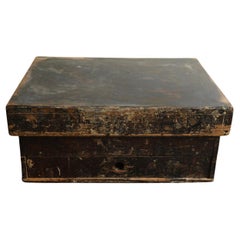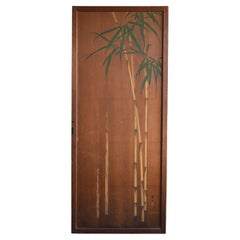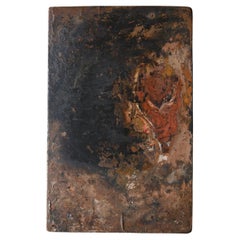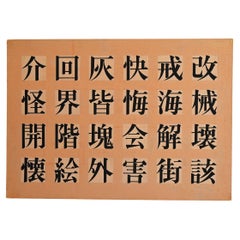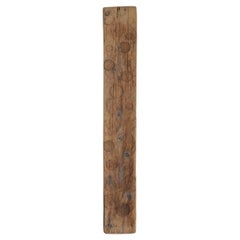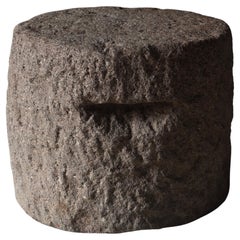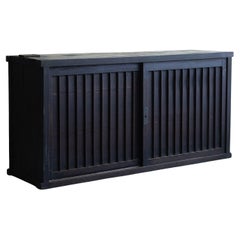Brood Paintings
to
6
Height
to
Width
to
1
1
4
4
3
1
1
1
6
6
6
6
6
6
Antique Japanese Buddhist pagoda hanging scroll /Buddhist painting/Edo
Located in Sammu-shi, Chiba
This is a slightly different Buddhist painting believed to have been created by a Japanese temple monk during the Edo period (late 17th to 19th century). Rendered in ink on paper, th...
Category
Antique 18th Century Japanese Edo Paintings
Materials
Paper
Wooden workbench of a Japanese lacquerware craftsman/20th century/wall-hanging
Located in Sammu-shi, Chiba
This is a lacquerware craftsman's workbench believed to have been actually used in Fukushima Prefecture and other areas in the Tohoku region between 1945 and 1960. This box-shaped st...
Category
20th Century Japanese Showa Paintings
Materials
Cedar, Lacquer
Wooden door with old Japanese bamboo painting/Wall hanging painting/Wooden door
Located in Sammu-shi, Chiba
This is a one-panel wooden door made in Japan around the 20th century. The material used is presumed to be Japanese cypress or Japanese cedar, and the delicately straight grain of th...
Category
20th Century Japanese Taisho Paintings
Materials
Cedar
Wooden work board of an old Japanese lacquerware craftsman/wall hanging object
Located in Sammu-shi, Chiba
This is a workbench used by a lacquerware craftsman around the Showa era. Originally, it was a workbench with drawers, but the drawer portion has been lost, leaving only the top boar...
Category
20th Century Japanese Showa Paintings
Materials
Wood
Japanese paintings with old kanji characters/20th century
Located in Sammu-shi, Chiba
This is a painting of kanji drawn in Japan around the 20th century.
The artist's name is unknown.
It is hand-drawn.
This is 24 Japanese kanji, each of which is pronounced "kai" or "g...
Category
20th Century Japanese Showa Paintings
Materials
Paint
Antique Work Board Used by Japanese Craftsmen/1868-1920/Wabi-Sabi Wall Painting
Located in Sammu-shi, Chiba
If you want something special, we recommend purchasing items selected by Brood.
We sell carefully selected old Japanese items.
I've seen tens of thousands of items so far.
Based o...
Category
Antique Late 19th Century Japanese Meiji Paintings
Materials
Cedar
Related Items
Japanese Antique Stone Display Stand / Objet / Before 1868s / Wabi-Sabi Mingei
Located in Iwate-gun Shizukuishi-cho, Iwate Prefecture
This is an old stone stand in Japan.
I don't know the details if it was used as a stand for beating straw, but it seems to be before the end of the Edo period.
The round silhouette...
Category
Antique Mid-19th Century Japanese Rustic Antiquities
Materials
Stone
$800
H 7.29 in Dm 9.06 in
Japanese Antique Cabinets, Wabi Sabi, Japandi
Located in Katori-Shi, 12
This is an antique Japanese-style cabinet made in the Meiji period.
The texture of the black lacquer, smoked with soot from the hearth, has a unique depth and charm that is unlike a...
Category
Early 20th Century Japanese Meiji Antiquities
Materials
Wood
FRAMED Still Life Oil Painting ARTWORK Wall Hanging
Located in Weehawken, NJ
Vintage framed Still Life Oil Painting of Fruit with Pitcher. Framed in a lovely wooden frame. Ready to hang with wire along the back.
French, circa 1920.
Size of frame: 16 x 18 i...
Category
Vintage 1920s French Provincial Paintings
Materials
Wood
19th Century Antique Japanese Meiji Bronze Floor Lamp
Located in Point Richmond, CA
19th century antique Japanese Meiji bronze floor lamp.
This finely cast, well composed, pedestal lamp depicts mythical creatures on the base, cranes in high relief on the stem are...
Category
Antique Late 19th Century Japanese Meiji Floor Lamps
Materials
Bronze
Japanese Antique Exhibition Table / Wall Decoration / 1868-1912s / Wabi-sabi
Located in Iwate-gun Shizukuishi-cho, Iwate Prefecture
This is an old Japanese wooden work board.
The wood is cedar, and due to long-term use, the black color around the edges remains, and the color has peeled off only in the middle. Th...
Category
Antique Late 19th Century Japanese Meiji Antiquities
Materials
Wood, Cedar
$500
H 2.88 in W 27.56 in D 8.27 in
Japanese Antique Cabinets , Low board Storage , Wabi Sabi, Japandi
Located in Katori-Shi, 12
This is an antique lowboard made in Japan. In Japan, it was used as a flooring.
A flooring is a platform that can be moved, like the floorboards of a tokonoma, which is indispensabl...
Category
Early 20th Century Japanese Taisho Antiquities
Materials
Wood
$3,900
H 9.93 in W 66.34 in D 8.47 in
Japanese Antique Wooden Board , Wall Decoration Abstract Art , Wabi-Sabi
Located in Katori-Shi, 12
This wooden board was made in the Taisho era.
It was used as a "mochi board." A "mochi board" is a board from the Meiji era that was used as a workbench for kneading flour, and is m...
Category
Early 20th Century Japanese Taisho Doors and Gates
Materials
Wood
$800
H 29.14 in W 25.99 in D 2.17 in
Japanese Antique Exhibition Stand / Sword Case / 1800-1868s / Wabi-sabi
Located in Iwate-gun Shizukuishi-cho, Iwate Prefecture
This is an old drawer for storing Japanese swords originally called "Katanatansu".
It is thought to be from around the Edo period.
Cedar is used for the material, and a large numbe...
Category
Antique Mid-19th Century Japanese Edo Antiquities
Materials
Wood, Paper, Cedar
$1,000
H 41.74 in W 5.91 in D 5.52 in
Japanese Antiques , Tapestries , Wabi-Sabi
Located in Katori-Shi, 12
We present to you a precious old wrapping paper from the Taisho period.
This washi paper was used to wrap important items. It was made by overlapping multiple ledgers, and is chara...
Category
Early 20th Century Japanese Taisho Paintings and Screens
Materials
Paper
Large Japanese 2-Panel Byôbu 屏風 'Room Divider' with Painting of Bamboo & a Poem
Located in Amsterdam, NL
Beautiful, large two-panel byôbu (room divider) with a serene painting of red-leaved bamboo and rocks on an oxidized silver leaf background. Silver leaf continuously undergoes the process of oxidation, which creates a beautiful aged patina.
On the left an inscription from a ‘Zekku’ poem by the Chinese poet Yang Zai (1271?1323), titled: Shan shang zhu (bamboo (painted) on a fan).
Translated as :
Why would people plant a lot of bamboos?
The shade of a single culm is also beautiful.
In the autumn night it rocks on the wind,
And the fresh sound echoes in my dream.
Dated: Shôwa, the year kôshin (1938). Signature unknown...
Category
Early 20th Century Japanese Paintings and Screens
Materials
Other, Silver Leaf
$3,807
H 68.71 in W 68.12 in D 0.71 in
Japanese Antique Door, Abstract Art Wabi Sabi, 1860s-1900s
Located in Katori-Shi, 12
Very old Japanese sliding door.
The simple design conveys the charm of the material.
You can feel the world of wabi and sabi.
Recommended as a wall painting.
It was made in the Mei...
Category
Early 20th Century Meiji Doors and Gates
Materials
Wood
Set of Four Japanese Fusuma Painted Door Panels
Located in Rio Vista, CA
Rare set of four Japanese Showa period door panels known as Fusuma in Japanese architecture. Similar to a Shoji room divider but made of an opaque materia...
Category
20th Century Japanese Showa Paintings and Screens
Materials
Brass
$2,400 Sale Price / set
20% Off
H 69.5 in W 36 in D 1 in

